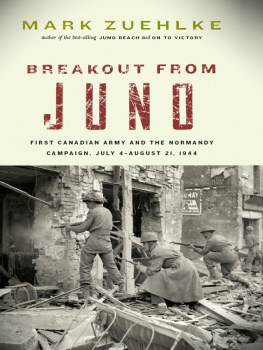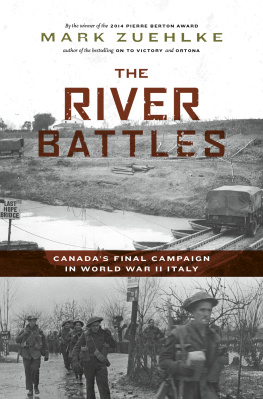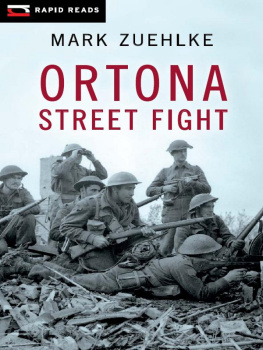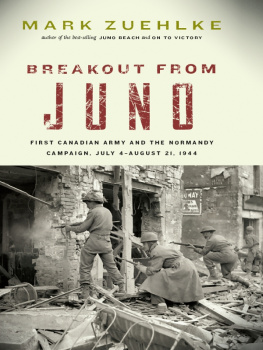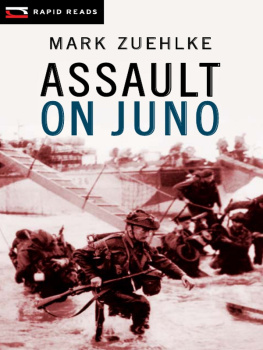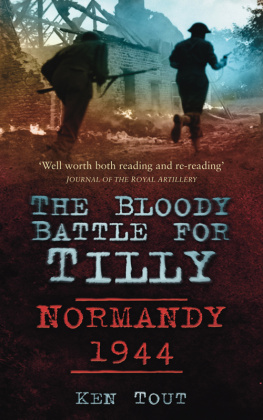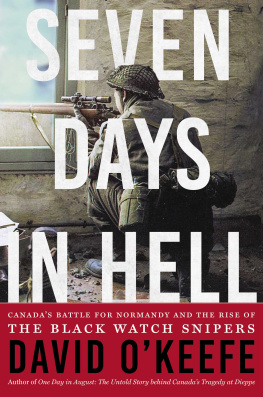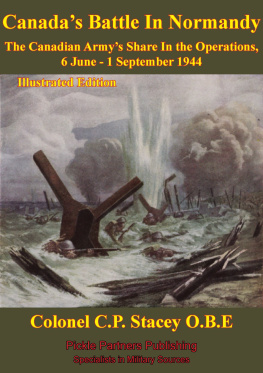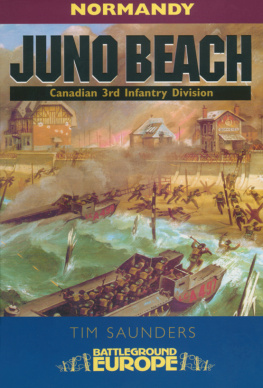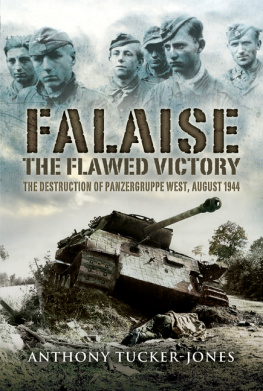
BREAKOUT FROM JUNO
FIRST CANADIAN ARMYAND THE NORMANDY CAMPAIGN,JULY 4-AUGUST 21, 1944
MARK ZUEHLKE
BREAKOUT FROM
JUNO

Copyright 2011 by Mark Zuehlke
First U.S. edition 2012
All rights reserved. No part of this book may be reproduced, stored in a retrieval system, or transmitted, in any form or by any means, without the prior written consent of the publisher or a licence from The Canadian Copyright Licensing Agency (Access Copyright). For a copyright licence, visit www.accesscopyright.ca or call toll free to 1-800 -893-5777.
Douglas & McIntyre
An imprint of D&M Publishers Inc.
2323 Quebec Street, Suite 201
Vancouver BC Canada V5T 4S7
www.douglas-mcintyre.com
Cataloguing data available from Library and Archives Canada
ISBN 978-1-55365-325-7 (cloth)
ISBN 978-1-55365-972-3 (ebook)
Editing by Kathy Vanderlinden
Copyediting by Ann-Marie Metten
Jacket photograph by Lt. Ken Bell, Canada. Dept. of National Defence, Library and Archives Canada, 1967-052 NPC, PA-132727
Maps by C. Stuart Daniel/Starshell Maps
based on sketch by Lt. Ken Gartley in Battle Accounts Algonquins, 612 August, 145.2A1013(DI), DHH, DND, and base map Potigny, 2nd ed., scale 1:25,000, 1944 Mar. (France 1:25,000 ; sheet no. 40/14 S.W.) (GSGS : 4347), grid ref 1449
Photos used with permission from Library and Archives Canada
We gratefully acknowledge the financial support of the Canada Council for the Arts, the British Columbia Arts Council, the Province of British Columbia through the Book Publishing Tax Credit, and the Government of Canada through the Canada Book Fund for our publishing activities.
THE CANADIAN BATTLE SERIES

On to Victory: The Canadian Liberation of the Netherlands, March 23May 5, 1945
Operation Husky: The Canadian Invasion of Sicily, July 10August 7, 1943
Terrible Victory: First Canadian Army and the Scheldt Estuary Campaign, September 13November 6, 1944
Holding Juno: Canadas Heroic Defence of the D-Day Beaches, June 712, 1944
Juno Beach: Canadas D-Day Victory: June 6, 1944
The Gothic Line: Canadas Month of Hell in World War II Italy
The Liri Valley: Canadas World War II Breakthrough to Rome
Ortona: Canadas Epic World War II Battle
OTHER MILITARY HISTORY BOOKS BY MARK ZUEHLKE

The Canadian Military Atlas: Four Centuries of Conflict from New France to Kosovo (with C. Stuart Daniel)
Brave Battalion: The Remarkable Saga of the 16th Battalion (Canadian Scottish) in the First World War
The Gallant Cause: Canadians in the Spanish Civil War, 19361939
For Honours Sake: The War of 1812 and the Brokering of an Uneasy Peace
Available from D&M Publishers Inc.
And so I have decided the time has come to have a real show down on the eastern flank.
General Bernard Law Montgomery, July 14, 1944
Forward, men! Weve got to keep going!
Major Philip Griffin, Black Watch Regiment of Canada, July 25, 1944
It was just a job to do because I realized that they were out to get me. If I didnt stop them, well, I guess thats the basics, isnt it, of war? You get the other guy before he gets you I was never a killer or anything, never wished to kill anyone, but I know I did.
Private Albert Clare Huffman, Argyll and Sutherland Highlanders
[ CONTENTS ]
T HE MONTHS OF July and August 1944 saw the greatest cataclysm of combat on the western European front during all of World War II. More than 2.5 million Americans, Britons, Canadians, Poles, and Germans locked in unrelenting battle within the narrow confines of a small part of Normandy. Here in the blood-soaked farm fields, bocage, woods, towns, and cities, soldiers fought with a desperate fury. Both sides knew the war was being decided in this conflict. When it ended, the Allies advanced towards victory, while the Germans could only delay that inevitability for as long as possible.
Yet these two monthsgenerally considered the crux of the Normandy Campaignhave always languished in the shadows of World War II history, eclipsed by that longest of days, June 6, 1944. D-Day, the great all-or-nothing gamble of the amphibious invasion of Normandy, is without doubt the climactic event of the western Allies war on Germany. Had the Canadians failed at Juno Beach, or the British at Gold and Sword, or the Americans at Utah and Omaha, World War II may have had a different outcome. And so, perhaps rightfully, it is the invasion that captures the popular imagination.
Despite the violence of the fight to gain the sand and stave off the hard counterattacks that followed from June 7 to 12, the long series of offensive operations in July and August were more costly. Throughout attempts to break free of the beaches and surge into the French heartland, victory was never assured and proved repeatedly elusiveeach Canadian win often reversed by a grim and bloody defeat.
Perhaps that is why this campaign is seldom accorded its unique and rightful place. Breakout from Juno is the first major account of First Canadian Armys operations over the course of these two months. Generally, this part of the armys story has been encompassed in accounts running from June 6 to the closing of the Falaise Gap on August 21. A few writers have focused only on one or two specific army operationsOperation Totalize, for example. The result is that much of the scope and significance of the fighting during those forty-eight days has been abbreviated, diminished, and, finally, lost.
One of the most daunting tasks in telling this story was managing the wealth of historical information available. The Canadian Army generated masses of reports, after-actions accounts, and interviews with officers and the occasional other rank to build a record of events. Failures, such as the disastrous July 25 Black Watch attack at Verrires Ridge, were extensively analyzed to determine what went wrong, how such a debacle could be prevented in future, and who, if anyone, was ultimately to blame. All of this information has greatly informed this book.
But historical records are not enough to bring history to life. For that I turned, once again, to the voices of the veterans. With so few still living and able to discuss their experiences, this book depends more on accounts hunted down in archives and a host of other sources. As before, the task is then to blend official accounts with the personal story. The battlefield is a place of chaos. Often exhausted and disoriented when they were young men fighting for their lives in a foreign land, old soldiers struggled to place a certain incident into the mosaic of an extended campaign. Many times it was access to extensive historical records that enabled a veterans unique experience of a few brief moments to be situated in time and place. These personal stories also informed and, in some cases, corrected the official accounts.
The Canadian Battle Series recognizes and honours the experiences and sacrifices of our soldiers during a time when a generation was called upon to step forward in the cause of world freedom. World War II was, as Studs Terkel has written, the last good war. But it was also a time when many young soldiers from all parts of our sprawling nation went into combat one day after another with only the scantest hope that they and their friends would live to see loved ones and home again.
Next page
